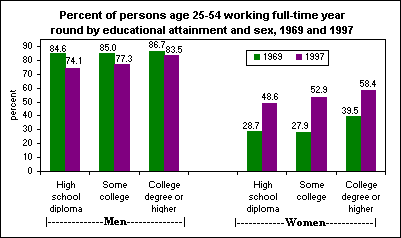An official website of the United States government
 United States Department of Labor
United States Department of Labor
From 1969 to 1997, the percent of persons age 25 to 54 working full-time year round increased from 53.0 percent to 62.6 percent, with changes varying by sex and educational attainment level.

[Chart data—TXT]
In 1969, a total of 27.5 percent of women age 25 to 54 worked full-time year round; by 1997, that percentage increased to 50.2 percent. By educational attainment, all groups of women experienced a rise in the percent working full-time year round. However, those women with a college degree or higher reported the smallest increase among the groups shown in the chart at 18.9 percentage points.
The percentage of men working full-time year round decreased from 80.6 percent in 1969 to 75.4 percent in 1997. By educational attainment, all groups of men experienced a decline in the percent working full-time year round; the largest decrease among the groups in the chart was for men with a high school diploma, down 10.5 percentage points.
These data are a product of the Current Population Survey program. Find out more in Chapter 3 of Report on the American Workforce 1999 (PDF 1,037K).
Bureau of Labor Statistics, U.S. Department of Labor, The Economics Daily, Change in percent of persons working full-time year round varies by sex and education at https://www.bls.gov/opub/ted/1999/sept/wk4/art05.htm (visited May 23, 2024).

